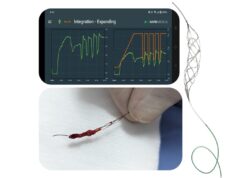 In a late-breaking presentation given on the final day of the International Stroke Conference (ISC) virtual meeting (17–19 March), researchers presented a “promising” new thrombectomy device that is reported to achieve a successful reperfusion in 84.6% of patients.
In a late-breaking presentation given on the final day of the International Stroke Conference (ISC) virtual meeting (17–19 March), researchers presented a “promising” new thrombectomy device that is reported to achieve a successful reperfusion in 84.6% of patients.
Jeffrey Saver (University of California, Los Angeles, Los Angeles, USA) and Rishi Gupta (Wellstar Health System, Marietta, USA) presented their findings from the TIGER (Treatment with the intent to generate endovascular reperfusion) trial.
“The trial confirmed that the Tigertriever (Rapid Medical) is not only safe and effective, but demonstrably improved outcomes over similar trials testing previous technology,” observed Saver. “Tigertriever is an important advance in stroke treatment devices and a win for patients.”
Tigertriever achieved superiority when compared to historical controls
In relation to their primary endpoints, Gupta reported that “superiority was achieved” when compared to historical control studies. This study saw 84.6% of patients achieve a modified treatment in cerebral ischaemia (mTICI) 2b–3 within three passes of the Tigertriever, compared to 73.4% with historical stent retrievers.
For efficacy, the primary outcome was successful revascularisation (mTICI 2b–3) within three passes with the Tigertriever. Secondary outcomes included good functional outcome—defined as a modified Rankin Score (mRS) between 0–2—at 90 days, first-pass successful revascularisation (mTICI 2b–3), and patient-reported outcome (PRO) scores.
For safety, the primary outcome was a composite of symptomatic haemorrhage at 24 hours (12–36 hours), and all-cause mortality by 90 days. Secondary outcomes included asymptomatic intracranial haemorrhage within 24 hours (1–36 hours), neurological deterioration (≥4-point increase on the National Institutes of Health Stroke Scale [NIHSS]) within the first 24 hours, and embolisations in previously uninvolved vascular territories (ENT).
In their serial revascularisation outcomes, researchers saw that, at the first pass with the Tigertriever, 57.8% of patients had an mTICI 2b–3. At the end of up to three Tigertriever passes, this was 84.6%, and after rescue devices were used at the end of procedure, it was 95.7%.
Regarding secondary endpoints, 58% of patients achieved an mRS of 0–2 at 90 days; this is compared to historical control where this outcome was 43%.
When comparing the primary safety endpoint, researchers compared 90-day mortality and/or intracranial haemorrhage at 24 hours. For the Tigertriever it was 18.1%, and for the historical control, this figure was at 20.4%.
The ISC audience was also given other safety endpoints: asymptomatic intracranial haemorrhage at 24 hours was 30.7% (in 36 patients), neurologic deterioration (≥4 NIHSS increase) was seen in 7.7% (9) of patients, and ENT in 2.6% (three) patients. In the historical control, the weighted average for ENT was 7.4%.
The median time from puncture to revascularisation was 24 minutes, which Gupta commented is a “very rapid reperfusion”. The median time from last known normal to puncture was 172 minutes, and last known normal to revascularisation was a median of 208 minutes.
Gupta concluded: “The Tigertriever is a highly-effective and safe device to remove thrombus in LVO stroke patients eligible for mechanical thrombectomy.”
Other devices
According to Saver, current devices failed to achieve successful reperfusion—defined as an mTICI score of 2b–3—in one-quarter of patients included in the HERMES (Endovascular thrombectomy after large-vessel ischaemic stroke) five-trial pooled analysis. They also failed to achieve excellent reperfusion (mTICI 2c–3) in two-thirds of patients.
In addition, many of the pivotal thrombectomy trials showed that current devices were associated with complications such as ENT in a small number of patients, and symptomatic intracranial haemorrhage in a low number of intracranial haemorrhages,
Saver communicated. Saver stated that the Tigertriever is a novel, radially adjustable, fully visible, stent retriever. He continued, “The physician controls the radial expansion and force according to visual and tactile feedback. This allows the device to be aligned with the target vessel diameter, and adjustment of the radial forces needed to penetrate the clot, while minimising vessel tension. Being fully visible, the device provides visual feedback and better operator control.”
Study design
Researchers state that the study objective was to evaluate the safety and effectiveness of the device in restoring blood flow by removing clots in patients with acute ischaemic stroke due to large vessel occlusion (AISLVO).
This was a multicentre, single-arm, prospective, objective performance criterion, investigational device exemption (IDE) study. There were a total of 17 sites, the device was compared with a performance goal derived from six pivotal trials of marketed stent retrievers (Solitaire, Medtronic and Trevo, Stryker).
Researchers screened 1,712 patients. Although 183 were eligible for angiography, 23 patients were excluded after due to the target clot being too distal. Enrolment took place across two phases: a lead-in and the main phase.
Enrolment for the lead-in phase of the study began in May 2018, and 43 patients were included. At this stage, sites enrolled up to four patients. Enrolment was completed when they either achieved two successful reperfusions or performed four cases following case review and approval by the central neurointerventionalist principal investigator.
In the main phase, 117 patients were enrolled. The data presented at ISC focused on this cohort. Enrolment ended in March 2020.
An independent core lab adjudicated angiogram images taken after each pass/attempt, including the first-pass effect, for three Tigertreiver passes, and at the end of the procedure after use of rescue devices in initial non-responders.
Group demographics
The mean age in this cohort was 65 years, 61.5% (72) of patients were male, the median NIHSS was 17, nearly two-thirds of patients received intravenous tissue plasminogen activator (t-PA) prior to treatment, the mean time to t-PA treatment was 95 minutes, and the mean ASPECTS (Alberta stroke programme early computed tomography score) was 8.9.
Comorbidies included hypertension in 76.9% (89) of patients, dyslipidaemia in 48.7% (57) of the cohort, atrial fibrillation in 40.2% (47), diabetes mellitus in 30.8% (36), and prior stroke/TIA in 13.7% (16).
The majority of patients’ target occlusions (57.3%; 67 individuals) were located in the middle cerebral artery (MCA) in the M1. Other locations included the intracranial internal carotid artery (20.5%; 24 patients), MCA in the M2 (19.7%; 23 patients), and the basilar artery (2.6%; three patients).
Disclosures:
Jeffrey L Saver: Serves as a principal investigator (PI) for the TIGER study (Rapid Medical) and acts as a consultant or is on the advisory board for Medtronic, Stryker, Cerenovos, and Rapid Medical. There is an institutional conflict of interest from the University of California, which has patent rights over stent retrieval devices for stroke.
Rishi Gupta: Serves as PI for the TIGER study (Rapid Medical), PI for the ASSIST registry (Stryker Neurovascular), and PI for the RECCLAIM II study (Zoll). He is on the Clinical Events Committee (CEC) for the MIND trial (Penumbra) and is a consultant for Cerenovos.









